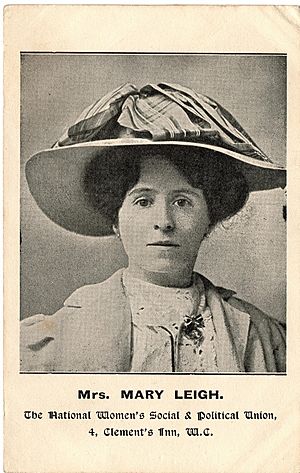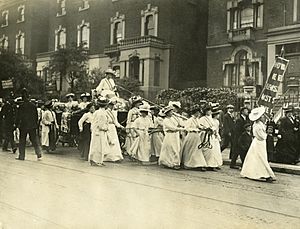Mary Leigh facts for kids
Quick facts for kids
Mary Leigh
|
|
|---|---|
 |
|
| Born |
Mary Brown
1885 Manchester, England,
United Kingdom of Great Britain and Ireland |
| Died | 1978 (aged 92–93) |
| Nationality | British |
| Occupation | Suffragette |
Mary Leigh (born Mary Brown; 1885–1978) was an English activist who fought for women's right to vote. She was a brave and determined suffragette, a name given to women who used protests and direct action to achieve voting rights for women.
Contents
Mary Leigh's Early Life and Activism
Mary Brown was born in Manchester, England, in 1885. She worked as a schoolteacher before she got married to a builder named Leigh. When she was about 20 or 21 years old, in 1906, Mary joined the Women's Social and Political Union (WSPU). This group was very important in the fight for women's suffrage (the right to vote).
Protesting for the Vote
Mary Leigh and other suffragettes often used bold methods to get attention for their cause. In 1908, Mary, along with Jennie Baines, Lucy Burns, Alice Paul, Emily Davison, and Mabel Capper, were arrested. They had tried to interrupt a political meeting to protest.
A year later, on September 17, 1909, Mary Leigh, Charlotte Marsh, and Patricia Woodlock climbed onto the roof of a building called Bingley Hall in Birmingham. They were protesting because they were not allowed into a meeting where the British Prime Minister, H. H. Asquith, was speaking. They threw some roof tiles towards the Prime Minister's car and the police to show their anger.
Time in Prison
For her actions, Mary Leigh was sentenced to four months in Winson Green Prison. While in prison, she continued to protest. She believed she should be treated as a political prisoner, not a regular criminal. To show her protest, she broke a window and started a hunger strike. This meant she refused to eat. Because of this, Mary and Patricia Woodlock were force-fed in prison in 1909. This was a very difficult experience where food was given to them against their will.
The WSPU recognized Mary Leigh's bravery and dedication. They gave her a special Hunger Strike Medal for her courage.
Continuing the Fight
On July 18, 1912, in Dublin, Mary Leigh threw a small hatchet towards Prime Minister Asquith. It accidentally hit John Redmond, an Irish political leader, instead. Even though Mary sometimes disagreed with the WSPU's leaders, she stayed loyal to the group. She felt a strong connection to the organization she had helped build.

In 1913, a famous suffragette named Emily Davison was seriously injured at the Epsom Derby horse race and later died. Mary Leigh and Rose Yates were with Emily Davison when she passed away. Mary also helped lead a special guard of honor during Emily's funeral procession.
Later that year, on October 13, 1913, Mary Leigh was hurt during a protest in London when police used clubs against protestors.
The WSPU Divides
When World War I began, there was a disagreement within the WSPU. The leader, Emmeline Pankhurst, decided that the WSPU should stop its protests for women's votes and instead support the government's efforts in the war. Mary Leigh and other suffragettes disagreed with this decision. They believed the fight for women's right to vote should continue.
Because of this disagreement, Mary Leigh, Rose Yates, and other members left the WSPU. They formed a new group called the "Suffragettes of the WSPU" (SWSPU) in 1916. This new group wanted to continue using strong protest methods to achieve women's suffrage. However, it did not become as large or influential as the original WSPU.
See also
- Women's suffrage in the United Kingdom
- Representation of the People Act 1918
- Representation of the People Act 1928

